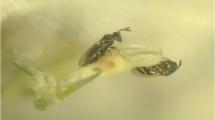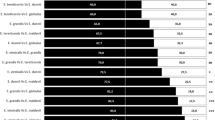Abstract
The response of red deer calves (Cervus elaphus) to the odors of Sitka spruce (Picea sitchensis) and lodgepole pine (Pinus conforta) needles and five monoterpene constituents of their essential oils was measured by simple two-choice feeding trials. All odors were significantly rejected (P < 0.05) except Sitka spruce and lodgepole pine by females and Sitka spruce and alpha-terpineol by males. Females had a stronger dislike of all odors except lodgepole pine than males. Rejection of monoterpene odors weakened slightly with time. A strong logarithmic relationship between the strength of the rejection response and vapor pressure of the compounds tested suggested that the odors were rejected on the basis of concentration rather than quality.
Similar content being viewed by others
References
Arnold, G.W., andHill, J.L. 1972. Chemical factors affecting selection of food plants by ruminants, pp. 71–101,in J.B. Harbourne (ed.). Phytochemical Ecology. Academic Press, New York.
Arnold, G.W., De Boer, E.S., andBoundy, C.A.P. 1980. The influence of odour and taste on the food preferences and food intake of sheep.Aust. J. Agric. Res. 31:571–587.
Conolly, G.E., Ellison, B.O., Fleming, J.W., Geng, S., Kepner, R.E., Longhurst, W.M., Oh, J.H., andRussell, G.F. 1980. Deer browsing of Douglas-fir (Pseudotsuga menziesii) trees in relation to volatile terpene composition and in vitro fermentability.For. Sci. 26(2):179–193.
Doty, R.L., Shaman, P., andDann, M. 1984. Development of the University of Pennsylvania smell identification test: A standardized microencapsulated test of olfactory function.Physiol. Behav. 32:489–502.
Jordan, T.E. 1954. Vapor Pressures of Organic Compounds. Interscience Publications, New York.
Kruska, D., andStephan, H. 1973. Volumenvergleich allokortikaler Hirnzentren bei Wild und Hausschwein.Acta Anat. 84:387–415.
Longhurst, W.M.,Oh, H.K.,Jones, M.B., andKepner, R.E. 1968. A basis for the palatibility of deer forage plants. 33rd North American Wildlife Conference, pp. 181–192.
Nagy, J.G., Steinhoff, H.W., andWard, G.M. 1964. Effects of essential oils of sagebrush on deer rumen microbial function.J. Wildl. Manage. 28(4):785–790.
Narjisse, H. 1981. The acceptability of big sagebrush to sheep and goats: Role of monoterpenes. PhD thesis. Utah State University.
Oh, H.K., Sakai, T., Jones, M.B., andLonghurst, W.M. 1967. Effects of various essential oils isolated from Douglas-fir needles upon sheep and deer rumen activity.Appl. Microbiol. 15(4):777–784.
Oh, J.H., Jones, M.B., Longhurst, W.M., andConnolly, G.E. 1970. Deer browsing and rumen microbial fermentation as affected by fertilization and growth stage.For. Sci. 16:21–27.
Ottoson, D. 1963. Some aspects of the function of the olfactory system.Pharmacol. Rev. 15:1–42.
Painter, W.W. 1971. Volatile oil content and consumption of juniper and its effects on deer rumen microbes. MSc thesis. Colorado State University, Fort Collins, 40 pp.
Radwan, M.A. 1972. Differences between Douglas-fir genotypes in relation to browsing preference by black-tailed deer.Can. J. For. Res. 2:250–255.
Rice, P. R., andChurch, D.C. 1974. Taste responses of deer to browse extracts, organic acids and odors.J. Wildl. Manage. 38(4):830–836.
Schwartz, C.C., Nagy, J.G., andRegelin, W.L. 1980a. Juniper oil yield, terpinoid concentration and antimicrobial effects on deer.J. Wildl. Manage. 44:107–113.
Schwartz, C.C., Regelin, W.L., andNagy, J.G. (1980b). Deer preference for juniper forage and volatile oil treated foods.J. Wildl. Manage. 44:114–120.
Stoddart, D.M. (1980).The Ecology of Vertebrate Olfaction. Chapman and Hall, New York.
Tribe, D.E. (1949). The importance of the sense of smell to grazing sheep.J. Agric. Sci. Cambr. 39:309–311.
Welch, B.L. andPederson, J.C. (1981).In-vitro digestibility among accessions of big sagebrush by wild mule deer and its relationship to monoterpinoid content.J. Range Manage. 34:380–384.
Author information
Authors and Affiliations
Additional information
Research supported by the Natural Environment Research Council and the Forestry Commission.
Rights and permissions
About this article
Cite this article
Elliott, S., Loudon, A. Effects of monoterpene odors on food selection by red deer calves (Cervus elaphus). J Chem Ecol 13, 1343–1349 (1987). https://doi.org/10.1007/BF01012281
Received:
Accepted:
Issue Date:
DOI: https://doi.org/10.1007/BF01012281




